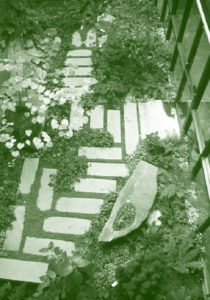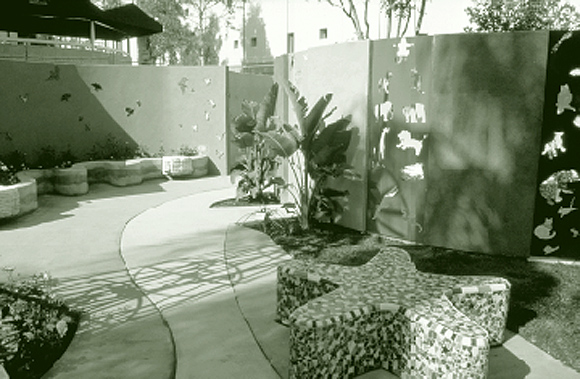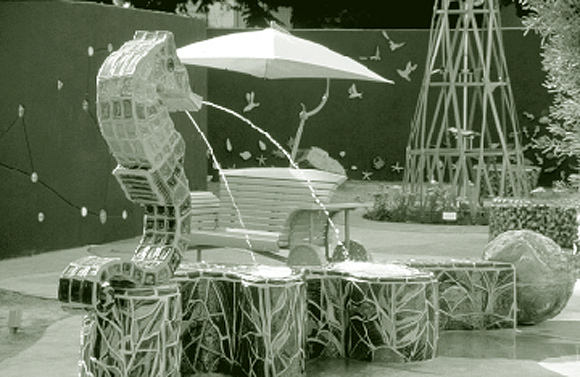“Our rooms will descend close to the ground and the garden will become an integral part of the house. The distinction between the indoors and the out-of-doors will disappear.”— Rudolph M. Schindler, 1926

Even a sleeping porch, in the right context, can be a healing garden. When the San Juan Regional Medical Center in Farmington, New Mexico wanted to expand their facility, they hired a firm specializing in healthcare design. A nurse in one of the planning meetings described an ongoing problem with the Navajo staff, who often refused to enter a room in which a patient had died. Many Navajo, whose reservation is just west of Farmington, believe that if a person dies in an enclosed area such as a patient room or a hogan, the person’s spirit becomes trapped in that space. A hogan would often be abandoned if someone died inside, and might even be burned down to free the spirit. While abandoning or burning down each room after a patient’s death was not an option, building an outdoor area onto each room was; and so the architects incorporated sleeping porches into the design. The architects also hired a landscape architect, a horticulturist, and consultants from the company Healing Landscapes as part of their team early in the design process. In addition to sleeping porches off every patient room, the team is designing a healing garden that will be physically accessible from the entrance, the main waiting area, and the cafeteria, and visible from many of the patient rooms and staff offices.
This story is remarkable because the architects assumed that the entire hospital campus—not just the building, but the whole property—should be conducive to healing. In a recent article for Healthcare Design, James Burnett talks about what he calls “mindful design,” in which restorative space is not confined just to a courtyard or rooftop garden, but is instead integrated throughout the site. “Why not make the entry sequence to a healthcare facility a healing experience? Could the concept of mindful design permeate the entire healthcare campus, including the full integration of all interior and exterior spaces? When is the last time you experienced a healing parking lot, a healing arrival court, a healing waiting room, or a healing cafeteria or dining terrace?” In California, several healthcare facilities have used this idea of mindful design. One excellent example is the Community Hospital of the Monterey Peninsula, conceived to feel less like a hospital and more like a retreat. The gardens—and there are gardens throughout the site—are only part of the design, which as a whole reflects deep care for the individuals whom the hospital serves, by respecting and utilizing the surrounding landscape.
Thus, a broad definition of healing gardens includes the entire healthcare facility, inside and out, as a fully cohesive restorative experience. An even broader definition of healing gardens includes places outside the healthcare setting. The Vietnam Memorial, the Golden Gate Park AIDS Memorial Grove, the San Francisco Garden Project, and Marcia Donahue’s Our Own Stuff Gallery, a residential garden open to the public, are all pertinent examples of therapeutic landscapes. Each of these places seems to be imbued with a kind of magic that works its way into the visitor, making the visiting experience more than the sum of its parts. Like any good healing garden, these are places for contemplation, inspiration, and renewal. If we do broaden our definition to include such sites, they can inform our design of the landscape within healthcare institutions as well.
Of course, private residential gardens can be healing gardens, too. A plethora of books has been published recently on the subject of garden as sanctuary, natural healer, balm for our stressed-out twenty-first century lives. Still, there is a distinction to be made between healing gardens for all and healing gardens for people with compromised health. We might call the former “wellness gardens” since they are designed to help well people stay healthy. A kind of preventative medicine, if you will. In public healthcare, however, the design process must be undertaken even more carefully with the user in mind, preferably based on sound research and observation, hence the term “research-based healthcare design.”
My own work has focused mostly on gardens in the healthcare setting, and people often ask me to define “healing garden” in that context: “Does the ‘healing’ come from medicinal plants, or the act of gardening, or just being in nature…and can’t any garden be a healing garden?” Healing garden, therapeutic landscape, restorative landscape, wellness garden—all of these terms describe outdoor spaces that, at the very least, facilitate a sense of well-being. In healthcare institutions, a healing garden is an antidote to the antiseptic medical facility, which for many of us—patients, visitors, and staff alike—epitomizes our fears of sickness and death. A healing garden is a place for people to go, outside of the confines of the building, to get away. Away from the squeak of nurses’ shoes, the smell of disinfectant, and the flicker of fluorescent lights. Away from other patients and hospital staff. A healing garden is a place to be alone or with family and friends, to think more clearly, or to be distracted; to sit, walk, maybe even run and play, where the surroundings remind us that there is life beyond hospital walls. A healing garden also reminds us that death is part of a natural cycle, which makes our own mortality seem a little less frightening. But most of all, a healing garden is about life and living.

In California alone, dozens of healthcare facilities, including general hospitals, children’s hospitals, nursing homes, Alzheimer’s treatment homes, psychiatric hospitals, and hospices have incorporated healing gardens for the benefit of patients, visitors, and staff. California is rich in examples of what I call passive healing gardens, where the primary goal is just to be in the garden. The healing garden at the University of California, Davis Medical Center (Sacramento) is another good example of utilizing the entire site. Instead of building a garden strictly for hospital users, the Medical Center worked with an adjacent elementary school to create a shared four-acre nature preserve. People from the Medical Center and the elementary school all use the paths, outdoor classroom, wildlife pond, and seating areas, which act as medical, educational, and of course environmental resources. The Healing Garden at the Marin General Hospital’s Outpatient Medical Building (Greenbrae), is one of the best-publicized healing gardens to date. Topher Delaney converted what had been a “leftover space” into a meditation garden after she survived breast cancer. The small space is filled with plants and a fountain that people can see through the Oncology Department’s large windows. Available at the garden’s entry is a lovingly designed handout that describes the plants in the garden, many of which have medicinal qualities.
At the opposite end of the spectrum is the Leichtag Family Healing Garden at the San Diego Children’s Hospital by the landscape architecture firm Delaney, Cochran, & Castillo. As the name implies, this garden was designed specifically for children and its theme is action (and distraction) rather than meditation and contemplation. Bright colors, animal sculptures, and a variety of paths and play areas encourage kids and their parents to explore, run around, and discover the many whimsical details. The garden has been somewhat controversial, criticized primarily for a dearth of plant material and quiet spaces for those who do not wish to play. Nevertheless, it is a refreshing change from most children’s hospitals, where the designers seem not to have been informed about the age of their principal clientele.

A smaller number of gardens have been designed for patients to take a more dynamic role in the therapeutic process. These “active healing gardens” are designed specifically for physical rehabilitation and usually incorporate horticultural therapy into their program. Horticultural therapy combines aspects of occupational therapy and physical therapy to aid in clients’ recovery in an outdoor setting. Whether they are actually gardening (watering, weeding, and working with plants) or using the garden as a space to try walking, sitting, talking, and performing other difficult recovery tasks, patients respond extremely well to this kind of therapy. Some gardens are a combination of active and passive. While some users are passing time in the garden waiting for test results or eating lunch, others are working with a speech therapist, learning to talk again by discussing the plant material around them.
Whether active, passive, or a combination, most successful healing gardens have some common characteristics that are based on research about what people respond to best. Of course, safety and accessibility are paramount in the healthcare environment, and are (or should be) taken into account. To use just one example, hospitals and nursing homes usually build paths with concrete, which is colored to reduce glare, because it is one of the easiest and safest walking surfaces available (just try rolling a wheelchair or IV pole over gravel). In terms of people’s preferences, one of the most important characteristics of a healing garden is greenery. People respond well to lush gardens bursting with life. Some other common elements of restorative landscapes are a “homelike” atmosphere (one that feels more like a modest private residence and less like a sleek corporate headquarters); a variety of places to sit and walk (sun and shade, private and public, large open spaces and quiet, intimate spaces); curvilinear shapes and soft surfaces; and the sound and sight of running water.
As healing gardens gain popularity and enter the mainstream, one of the challenges designers face is how to keep them from becoming pre-packaged, soulless theme gardens. How can we base our designs on sound research without running through a checklist that makes cookie-cutter healing gardens that no longer heal? Can we keep each design fresh, inspired, and compassionate and follow the research and recommendations? A lot of healthy dialogue is taking place about who should design restorative landscapes—should they have some sort of certificate, should they sign some kind of healing garden Hippocratic Oath? To think of the many gardens that would not have been built because the designer lacked the necessary credentials is to realize that such an exclusive approach will not work. These are just some of the questions with which those involved in research-based healthcare design have been grappling.
Architects are clearly an important part of the ongoing discussion about healing gardens. Their understanding of how space, light, color, and materials affect people’s state of mind is indispensable knowledge. Today’s architects have been profoundly influenced by their predecessors, many of whom were intent on blurring the distinction between inside and outside spaces long before the term healing gardens was ever uttered. Classic examples that spring to mind are Fallingwater, the Farnsworth House, and the Case Study houses. If architects can use that same respect for, and letting in of, nature for an institutional setting, we’ll be able to design places where, when the time comes, we’ll feel that much better about sending our loved ones, our friends, even ourselves.
HEALING LANDSCAPES: A RESOURCE LIST
Naomi Sachs
The three books on restorative landscapes that I’ve found to be most useful are:
- Healing Gardens: Therapeutic Benefits and Design Recommendations, eds. Clare Cooper Marcus and Marni Barnes, NY: John Wiley & Sons, Inc., 1999.
- The Healing Landscape: Therapeutic Outdoor Environments, Martha Tyson, New York: McGraw-Hill Companies, Inc., 1998.
- Restorative Gardens: The Healing Landscape, Nancy Gerlach-Spriggs, Richard Enoch Kaufman, and Sam Bass Warner, Jr., New Haven: Yale University Press, 1998.
(Healing Gardens and Restorative Gardens both have excellent information on the history of gardens in the healthcare setting.)
Other books about restorative landscapes geared to design professionals:
- Design That Cares: Planning Health Facilities for Patients and Visitors, Janet Carpman, Myron Grant, & Deborah Simmons, Chicago: American Hospital Association, 1993.
- Healthcare Design, Sarah O. Marberry, ed., New York: John Wiley & Sons, 1997.
- Human Spaces: Life-Enhancing Designs for Healing, Working, and Living, Barbara Crisp, Gloucester, MA: Rockport Publishers, Inc., 1998,
- Landscape Design for Elderly and Disabled People, Jane Stoneham and Peter Thoday, United Kingdom: Packard Publishing Ltd., 1994.
- Plants for Play, Robin C. Moore, Berkeley, CA: MIG Communications, 1993 (Children’s gardens).
Books about healing gardens geared to the home gardener:
- Contemplative Gardens, Julie Moir Messervy and Sam Abell, Charlottesville, VA: Howell Press, 1999.
- Creating Eden: The Garden as a Healing Space, Marilyn Barrett, San Francisco: Harper San Francisco, 1992.
- Cultivating Sacred Space: Gardening for the Soul, Elizabeth Murray, San Francisco: Pomegranate, 1997.
- Derek Jarman’s Garden, Derek Jarman and Howard Sooley, Woodstock, NY: The Overlook Press, 1996.
- Feng Shui in the Garden, Nancilee Wydra, Illinois: Contemporary Books, 1997.
- Garden Retreats: Creating an Outdoor Sanctuary, Barbara Blossom Ashmun, San Francisco: Chronicle Books, 2000.
- Gardens for the Soul, Pamela Woods, New York: Rizzoli International Publications, Inc., 2002.
- The Healing Garden, Sue Minter, Boston: Charles E. Tuttle Company, 1993.
- Healing Gardens, Romy Rawlings, Minocqua, WI: Willow Creek Press, Inc., 1998 (This book is well-written and chock full of information—highly recommended for this genre.)
- Sanctuary: Gardening for the Soul, Laurie Brunton and Erin Fournier, New York: Friedman/Fairfax Publishers, 1999.
Some books (and one article) considered to be the “backbone” of the healing gardens movement:
- The Biophilia Hypothesis, Stephen R. Kellert and Edward O. Wilson, eds., Washington, D.C.: Island Press, 1993.
- The Experience of Landscape, Jay Appleton, Chichester, New York: Wiley & Sons, 1996.
- The Experience of Nature: A Psychological Perspective, Stephen and Rachel Kaplan, Cambridge: Cambridge University Press, 1989.
- A Pattern Language, Christopher Alexander, Sara Ishikawa, & Murray Silverstein, New York: Oxford University Press, 1977.
- The Role of Horticulture in Human Well-Being and Social Development, Diane Relf, ed., Portland, OR: Timber Press, 1992.
- “View Through a Window May Influence Recovery from Surgery,” Roger S. Ulrich, Science, Vol. 224, 1984.
Resources on the web (these two sites contain many other useful links):
- Healing Landscapes Database. This is my own website, a free informational database about healing gardens and related topics.
- American Horticultural Therapy Association (AHTA).
Visiting
Reading is great, but one of the best ways to get a sense for how healing gardens work is to visit them. Marcus and Barnes’ Healing Gardens lists hundreds of gardens, many in California. My website, the Healing Landscapes Database, provides an extensive list of restorative outdoor spaces. Prospective visitors should be aware that some gardens, even in general hospitals, are not open to the public; it’s always a good idea to call ahead and make sure that a spontaneous visit will not be disruptive to patients and staff.
Author Naomi Sachs received her Master of Landscape Architecture at UC Berkeley. In 1999, she founded the Restorative Landscapes Database an online resource on healing gardens and related topics. She is principal of Sachs Design, a design and consulting company with an emphasis on therapeutic landscapes.
Originally published 4th quarter 2003, in arcCA 03.4, “Reflect Renew.”





